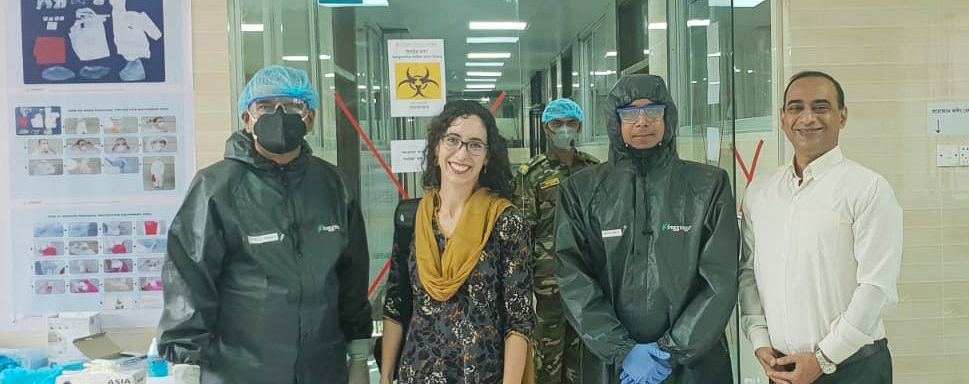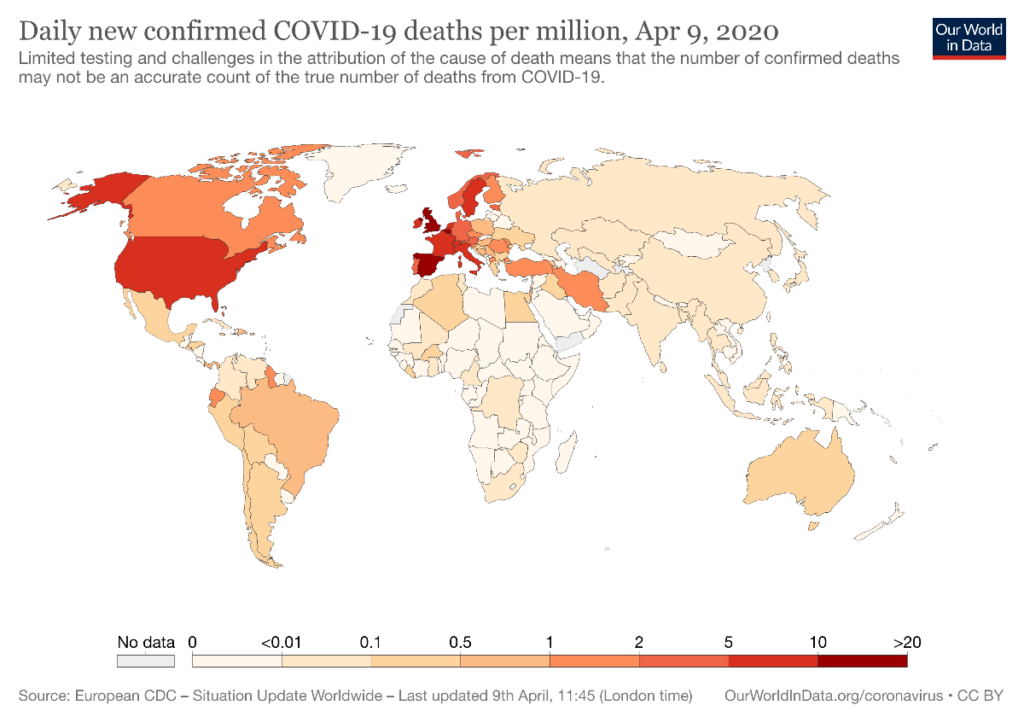Published: 04/09/2020
Dear Global Health Colleagues,
As the global burden of COVID-19 continues to increase, we at the Center for Innovation and Global Health are encouraged that some countries and regions are seeing improvements in hospitalizations and deaths, and are acting to address the economic consequences of the pandemic. However, we remain especially concerned for vulnerable and underserved populations locally and globally.
Since our last newsletter, there has been increased recognition in the press and medical community about the important intersections of COVID-19 with race, gender, and political and socio-economic status. The centrality of human and planetary health is being highlighted by calls to ban wet markets and by research relating air pollution to COVID-19 mortality. Some of these publications are highlighted below. We continue to encourage and call for more of these efforts. Lastly I am participating in a COVID19 curated art competition—feel free to submit and vote here. We hope the following resources are helpful. Stay healthy.
In solidarity against COVID-19,
Michele Barry
Drs. Ben and A. Jess Shenson Professor of Medicine and Tropical Diseases
Director of the Center for Innovation in Global Health
Senior Associate Dean for Global Health, Stanford University
Continue to monitor the following reliable websites for the global situation:
NIH/NLM | LitCovid—–LitCovid is a curated literature hub for tracking up-to-date scientific information about the 2019 novel Coronavirus. It is the most comprehensive resource on the subject, providing a central access to relevant articles in PubMed. The articles are updated daily and are further categorized by different research topics and geographic locations for improved access.
Resources
Domestic Underserved Populations and Health Disparities
Exposure to air pollution and COVID-19 mortality in the United States (4/5/2020): In a preliminary manuscript from Harvard’s T. H. Chan School of Public Health, Wu et al. examine data from 3,000 counties in the United States and show that increased exposure to fine particulate matter is associated with increased COVID-19 death rate.
The coronavirus is infecting and killing black Americans at an alarmingly high rate (4/7/2020): The Washington Post reviews early data showing a disproportionate number of African Americans are dying from COVID-19. The article describes how health disparities, discrimination, and generational inequality are contributing to the COVID-19 crisis in the United States.
Does Covid-19 Hit Women and Men Differently? U.S. Isn’t Keeping Track (4/3/2020): The New York Times questions why the CDC is not reporting sex-disaggregated data when men and women may have different reactions to the virus, vaccines, and treatment.
In N.Y.C., the Coronavirus Is Killing Men Twice as Often as Women (4/7/2020): The New York Times reports that there have been 43 Covid-19 deaths for every 100,000 men in the city compared with 23 such deaths for every 100,000 women. The article briefly considers possible explanations including gender-based differences in behavior (e.g. smoking) and immune systems. We know that women respond to vaccination better and have more autoimmune diseases so stay tuned for more research in this area.
Global Trends and Topics
Refugee and migrant health in the COVID-19 response (3/31/2020): Hans Kluge et al. describe in The Lancet how refugees and migrants are affected by COVID-19. The authors call attention to the impact of tightening borders and restricting travel, and they point to the urgent need to improve conditions in refugee camps.
Flattening the Curve for Incarcerated Populations — Covid-19 in Jails and Prisons (4/2/2020): In the NEJM, Matthew Akiyama et al. call for improved preparation and increased decarceration to minimize the impact of the pandemic on incarcerated persons and surrounding communities.
The Impact of COVID-19 on Gender Equality (April 2020): This NBER working paper by Titan Alon et al. explores how the economic downturn caused by COVID-19 has implications for gender equality. The authors describe how social distancing, working from home, and school closures will have a disproportionate negative effect on women and their employment opportunities.
Four Lessons from Outbreaks in Africa for the Age of Coronavirus (3/30/2020): Aly Verjee from the US Institute of Peace uses examples of polio, Ebola, HIV/AIDS, and yellow fever to explain why it is critical to engage local authorities, understand affected communities’ priorities, avoid stigmatizing victims, and create broad coalitions for response.
COVID-19 from a global health perspective: A podcast (4/6/2020): Listen to Michele Barry and Paul Costello discuss COVID-19 and the origin of pandemics, the importance of planetary health, and the need for increased global collaboration.
Can We Reimagine Global Health In The Post-Pandemic World? (4/6/2020): In Forbes, Madhukar Pai considers how COVID-19 will change the field of global health. He hopes there will be more consensus about supporting health systems, strengthening the WHO, and learning from LMICs. He’s also concerned the pandemic will disrupt routine health services in LMICs, lead to reductions in development assistance, increase nationalism and isolationism, and encourage more security-focused global health agendas.
Country-Specific News
The pandemic is a portal (4/3/2020): In the Financial Times, novelist and activist Arundhati Roy describes how India’s struggle against COVID-19 is intimately linked to existing structural, social, and economic inequalities.
A German Exception? Why the Country’s Coronavirus Death Rate Is Low (4/4/2020): The New York Times considers how Germany’s low COVID-19 mortality rate may be related to a younger average age among those infected, widespread testing and tracking, robust public health system, and trust in government.
President Ramaphosa Leads Strong Response to COVID-19 in South Africa (4/7/2020): John Campbell from the Council on Foreign Relations explains how South Africa has imposed some of the strictest coronavirus policies outside of China and so far seen a limited number of cases and deaths.
Love in the time of COVID-19: negligence in the Nicaraguan response (4/6/2020): In The Lancet Global Health, Thais Mather et al. describe how the Nicaraguan government has not declared a state of emergency, restricted travel, closed borders, or suspended schooling or public events. The authors call for improved disease prevention and containment.
Coronavirus is testing the limits of Russia’s surveillance state (4/5/2020): Isabelle Khurshudyan of the Washington Post describes the debate in Russia about using phones and QR-code passes to track movement and enforce stay-at-home orders.
As normalcy returns, can China keep COVID-19 at bay? (4/3/2020): Dennis Normile writes in Science about the challenges that face China as its COVID-19 lockdown is lifted. To guard against flare-ups, the government continues to regulate travel, aggressively monitor for new infections, and pursue thorough contact tracing.
Austria and Denmark are first in Europe to announce easing of coronavirus lockdowns (4/6/2020): Michael Birnbaum of the Washington Post describes plans to lift restrictions starting on April 14 in Austria and April 15 in Denmark.
Notes from the field: Bangladesh

Notes from the field from Ashley Styczynski, MD, MPH
Stanford infectious disease fellow in the Division of Infectious Diseases & Geographic Medicine

Bangladesh has been on government-mandated shutdown for two weeks. We received several days’ advanced warning of the shutdown, prompting 10 million people to leave the capital city of Dhaka for their home villages, despite government edicts to the contrary. The normally clamoring city of 20 million suddenly feels like a quiet, peaceful place. With strict shelter-in-place orders, families gather on rooftops in the evenings for their daily dose of fresh air.
Well, not exactly fresh, but fresher than it’s been in months. My air quality index app now tells me we have reached “unhealthy” levels, which is worth celebrating after months of “hazardous.”
It’s hard to say if this is the calm before the storm because testing for COVID-19 has been very limited, leading to two divergent views: either Allah has spared us or the government is hiding the truth and we’re all going to die. The dominant sentiment varies by the news stories of the day. R0 represents the average number of secondary cases generated by an infected individual. And it turns out that the R0 of fear is greater than the R0 of coronavirus. The fear doesn’t lead to productive preparation but irrational behavior, such as spraying disinfectant on the roads. If only we could do that in the hospitals, we might be getting somewhere!
The hospitals are naively blind to what is likely to be our new reality in a few short weeks, given the limited supplies of oxygen and PPE. The only real planning I’ve seen has come from the military hospitals, which have converted barracks into quarantine stations, set up triage tents, and created holsters for hand sanitizers to promote point-of-care hand hygiene.
I had the opportunity to observe these when they requested a workshop on triage and infection control for COVID-19 preparedness. However, after seeing what they were already doing, I’m convinced that they had more to teach me than I had to teach them.
I think the country might have a fighting chance if the military were asked to run the response. Until then, I will continue doing what I can to protect myself, primarily through hand washing and social distancing, while trying to figure out how to make these rare luxuries available to the rest of Bangladesh.
Upcoming Events and Lectures
Principles of Disaster Preparedness & Infectious Disease Outbreaks Course
This free, 9-hour course has been designed by the University of Minnesota to improve understanding of infectious disease outbreaks and control. While it was crafted during and in response to the COVID-19 pandemic, it does not contain COVID-19 specific lectures, as all lectures predate this pandemic, dating from 2015 to 2019.
Register here.
COVID-19 Spring Quarter Elective for Stanford Students (PEDS19SI)
This new spring course elective will provide up-to-date information and create an open space to engage with primary literature, case studies, and expert voices concerning various issues pertinent to the COVID-19 pandemic, from the frontlines to the lab. Open to all students of all degree programs. Thursdays 7:00 – 7:50 pm on Zoom. Sign up on Axess.
Questions? Alana O’Mara, aeomara@stanford.edu; Dr. Rishi Mediratta, rishimd@stanford.edu
New Funding Opportunities Specific to COVID-19
Stanford CIGH COVID-19 Global Response Seed Grants
Purpose: The Center for Innovation in Global Health is offering seed grants valued at $10,000 to $50,000 for creative Stanford teams to begin to develop solutions to address the COVID-19 crisis. This special seed grant program encourages the development of rapid and innovative responses to help curb the COVID-19 pandemic, particularly in low- and middle-income countries and underserved areas of the US. The program seeks to support the development of practical, low-cost solutions; and catalyze Stanford’s vibrant global health research community.
Deadline: April 15, 2020
Submission Information: Please apply via the Stanford Seed Funding site.
Review full program announcement here.
Online List of COVID-19 Research Opportunities
Stanford’s Research Management Group has created a website that provides a complete listing of funding opportunities for COVID-19 research. The site also provides sponsor and University guidance on grants, clinical trials, and award management impacted by COVID-19.
See funding opportunities.
COVID-19 Research at Stanford
Stanford Medicine scientists have launched dozens of research projects as part of the global response to COVID-19. Some aim to prevent, diagnose and treat the disease; others aim to understand how it spreads and how people’s immune systems respond to it.

